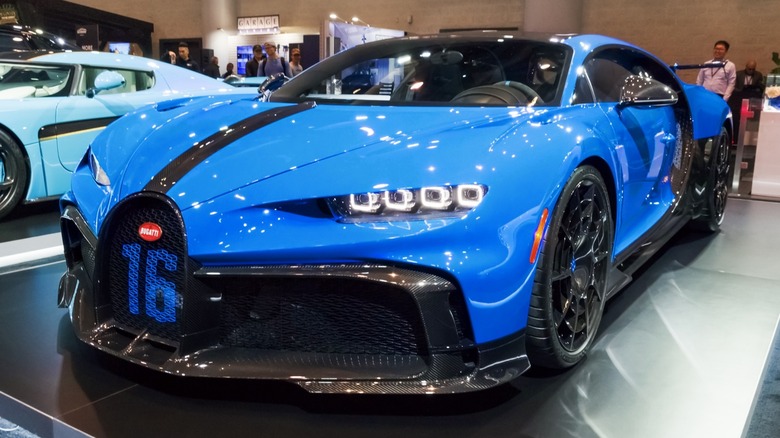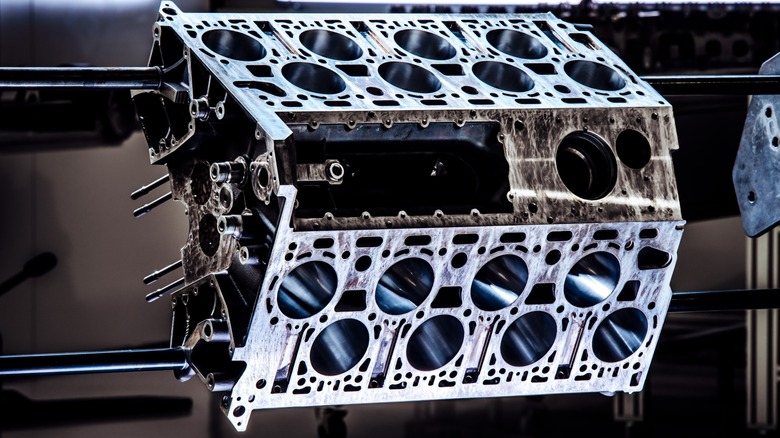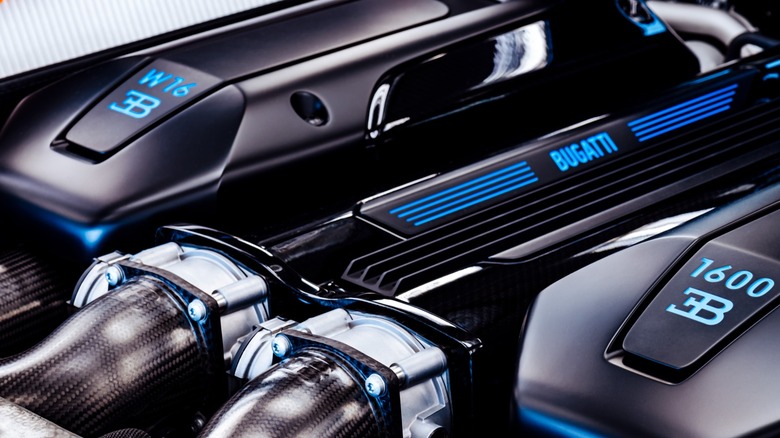What Engine Does The Bugatti Chiron Have & How Much HP Does It Produce?
With its name uttered in the same exclusive automotive-enthusiast circles as Ferrari, McLaren, and Koenigsegg, Bugatti ranks among the best hypercars of all time. With comparisons like that, you'd expect a Bugatti Chiron to be expensive, and you'd be right. Car and Driver reports starting prices for the discontinued 2022 Bugatti Chiron at $3.3 million.
Bugatti wrapped up Chiron production this year with the 500th model that MotorTrend calls a "special celebratory Super Sport." Since its 2016 debut, every Bugatti Chiron — except for this stunning homemade Bugatti – has been equipped with an 8.0-liter W16 engine. While the W16's architecture remained unchanged from its debut in the Veyron 16.4 in 2005, Bugatti engineers increased its power output before installing it in the Chiron.
With the end of the Chiron, Bugatti is also retiring the W16 engine design. Instead, Bugatti will install a V16 hybrid powertrain in its newest hypercar. While the Bugatti boasts increased performance numbers for the new hybrid powertrain, the 8.3-liter naturally aspirated V16 engine on its own is less powerful than the legendary W16 it replaces.
The original Bugatti W16 engine
Before being fitted into the first Bugatti Chiron in 2016, the automaker placed the powerful 8.0-liter W16 engine in the 2005 Bugatti Veyron 16.4. That original W16 produced 1,001 PS (987 horsepower), capable of propelling the Veyron 16.4 from zero to 100 kph (62 mph) in 2.5 seconds and a 400 kph (249 mph) top speed. In a 2022 press release, Bugatti proclaimed the W16-powered Veyron as "the world's first hyper sports car."
The impetus behind the unusual design of the Bugatti W16 engine came in 1997 when Ferdinand Karl Piëch, as Chairman of the Board of Management of Volkswagen AG, sketched an 18-cylinder W engine design on an envelope while traveling by train from Tokyo to Osaka. The design eventually lost two cylinders during development, similar to a 16-cylinder engine envisioned by Ettore Bugatti years earlier.
Among the W16 engine design's benefits are its compact size and relatively light weight, The Bugatti W16 occupies about the same space as a V12 and weighs around 400 kg (882 pounds). The W16's incredible engine design is often described as two V8s joined together with their cylinders next to each other, but slightly offset. All 16 pistons share the same crankshaft, and each bank of eight cylinders uses one cylinder head with four-valves per cylinder.
The W16 was improved for the Bugatti Chiron
With the Veyron 16.4 W16 engine as a starting point, Bugatti engineers went back to the proverbial drawing board — envisioning a quieter engine with more power, better efficiency, and reduced emissions while keeping the same footprint for the Bugatti Chiron. Bugatti claims that the only aspects unchanged from the original W16 were its "compact engine shape and the pitch of 73 millimeters" (2.87 inches) between cylinder bore centers.
The Bugatti Chiron Super Sport's redesigned 8.0-liter W16 featured a larger turbocharger system with four exhaust-gas-driven sequential turbochargers. The two-stage sequential turbochargers allow for full-time boost from a single turbo on each bank of cylinders, with another turbo on each bank at the ready when more power is demanded. Bugatti says the system's four turbos are all the same size to maintain a steady torque curve through the rev range.
Horsepower ratings for the 8.0-liter W16 Bugatti Chiron come in at 1,500 PS (1479 horsepower), a 50-percent increase over the original Veyron 16.4 W16 rating. The new engine also produced 1,600 nm (1,180 lb-ft) of torque, a significant increase over the older Veyron's 1250 nm (922 lb-ft).
Bugatti engine tuners coaxed an additional 100 PS (98.6 horsepower) from the 2019 8.0-liter W16 for a total of 1,600 PS (1578 horsepower). The 2019 Bugatti Chiron Super Sport 300+ proved to be the fastest production automobile at the time, and the first to break the 300 mph mark. During testing, the 300+ attained a top speed of 490.484 kph (304.773 mph) on a closed course.


